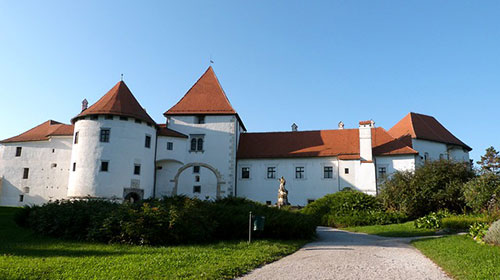Continental Croatia is an oasis of tranquility, with gentle hills home to age-old forests, vineyards and the Sava, Drava and Mura rivers sheltering the local towns from the summer heat. With its rivers, springs, mountains, woods and untouched forests, and not to mention lakes, pools, gorges and caves, the inland region of Lika-Karlovac has Croatia’s highest concentration of national and natural parks.
A mere stone’s throw to the north and northeast of capital Zagreb, the region is dotted with romantic medieval towns such as Koprivnica or Varaždin, countryside manors such as Trakošćan Castle and thermal spas perfect for restoring your energies, leaving you revitalised and full of life.
Samobor - A paradise for gourmets
Samobor is a small town in the north of Croatia, 20 kilometres away from the Croatian capital and 5 km from the Slovenian border. It is located on the slopes of the Samobor mountains, at the entrance to the romantic valley of Gradna stream. This is a medieval town of Baroque architecture, surrounded by a wide mountain range from the town of Okić to Plešivica, Oštrca and Japetić to Žumberak.
There is the especially attractive Anin dol and Grgosova spilja, the most beautiful caves in north-western Croatian. This picturesque town with its preserved city centre has a long excursion and tourist tradition and is the cradle of mountaineering in Croatia.
Besides the carnival, Samobor is known among gourmets for its custard pastry (kremšnita), a sweet cake made of cream foam. Samobor's custard pastries are also special in that they are eaten hot, and everywhere else are served exclusively as chilled cakes.
Krapina Neanderthal Museum
The unique Krapina Neanderthal Museum opened in 2010 and is located near one of Europe’s most important paleontological sites. The museum features exhibitions about the Neanderthals and about the history of the Earth, from its origins to modern times.
With its multimedia contents, the museum takes its visitors back to the age of the Neanderthals and they become part of evolution. Visitors go back 130,000 years in history and observe the virtual reality of their ancestors from Krapina.
The exhibition area of the museum is located between two hills – Hušnjakovo and Josipovac – and is spread over 1,200 square metres, split into two levels. The Neanderthals lived in so-called semi-caves, holes created by water in vertical bare rocks, mostly without vegetation, which were protected from three sides. There was only one opening on the front side from where they could watch out for enemies. The museum building is similarly constructed, almost invisible from the outside, resembling a concrete semi-cave covered in sand. The entrance to the museum blends in with the surroundings so it seems as if the visitors are entering a cave, becoming its inhabitant.
Medvednica
Medvednica Mountain is covered with dense beech, oak, chestnut and fir forest and it certainly is favourite excursion destination for the Zagreb citizens and their guests. The mountain is criss-crossed by numerous paths and trails, less demanding ones that are fitted with benches and information boards and those more demanding suitable for mountaineers. The ruins of the medieval town Medvedgrad, located on an elevation in dense forest, a mere half an hour walk from the last of the city’s houses, are one of the most popular sites on Medvednica.
Medvednica hides other attractions too: ravines, caves, waterfalls, old mine shafts and small picturesque churches. Most people visit its peak, Sljeme, which is dominated by a TV broadcasting tower. Located around the summit are numerous mountain lodges where visitors, hikers and climbers can rest and restore their energy with popular “Sljeme” specialties such as bean soup with sausages and apple or cottage-cheese strudel.
Lonjsko polje
The largest nature park in Central Croatia is Lonjsko polje, located in the valley of the river Sava, east of Zagreb. Covering an area of 506 km2, it is one of the largest European preserved wetlands, protected by the Ramsar Convention as a wetland area of the world importance. The park provides an atmosphere of peace and tranquillity typical of wide wetland expanses. Growing alongside calm waters covered in water lilies are iconic oak forests, particularly beautiful at dusk.
However, by far the greatest wealth of Lonjsko polje is in its 250 bird species. These include numerous small birds and different types of duck. The best known inhabitants of the park are storks, which habitually build their nests on the roofs of the lovely timber built village houses. One such village is Čigoć, in 1994 declared to be the first European Village of Storks. Needless to say, the waters of Lonjsko polje attract other creatures such as snakes but we should point out that there are fewer poisonous snakes here than in the rocky south of Croatia.
Varaždin
Varaždin is the centre and the headquarters of the County of Varaždin. The very diverse and rich cultural heritage are a part of its tumultuous past and rules. It is a city museum, a city of exhibitions, fashion, pupils and students, a city of modern life. It is most proud of the historic Old Town, where there are palaces, churches and monasteries dating back to the Baroque, Art Nouveau, and Rococo periods and has one of the oldest town halls in Europe.
The famous theatre and cemetery is a monument of landscape architecture, which has encircled the entire city. During the year there is a lively scene of cultural, sporting and other events that make it a pleasant place to live in. Baroque music echoes in the nights every autumn in the beautiful Baroque atmosphere of religious and secular buildings, and the festival of street performers Špancir fest shows how relaxed life is in Varaždin!
Rastoke – Millers’ Village
The village of Rastoke grew out of the harmonious marriage of man and nature that reaches back over 300 years. The joy of life reflects in the bubbling confluence of the Slunjčica and Korana rivers, where a multitude of waterfalls, tiny lakes and cascades tell the story of the true beauty of nature.
The Star of Karlovac – The Renaissance Core of the Town of Karlovac
The town of Karlovac, located on four rivers, was built in the sixteenth century with a unique town centre in the shape of a six-pointed star and an exact geometrical network of streets, town quarters and the central square.
There are definitely things to be seen in Karlovac: the old town of Dubovac that was built in the 13th century, the Town Museum, Church of Presveto Trojstvo [Holy Trinity] and the Franciscan monastery with a gallery, the town’s theatre Zorin dom and some of the galleries. At the feudal fair in Dubovac, old crafts, customs and games are presented with dishes that are prepared according to old recipes.
Ozalj
The ancient town of Ozalj, built on a gorge overlooking the river Kupa where it transforms from a flat to a hilly course, is nestled between forested hills and emerald river. In the 18th century, this medieval town was converted into a castle. Behind the beautiful neo-renaissance facade of the building lies another cultural monument - Munjara hydro. There is also a city museum, and an ethno-park as part of the museum.
For a pleasant holiday Ozalj and its surroundings offer a fresh river, the warmth of the sun, swimming in the Dobra, Kupa or Šljunčara. Hunting, fishing, biking in the Žumberak nature park, tours in the beautiful surroundings will delight all intentional and accidental passers-by!
Immersed in the aroma of chestnuts
Complots and Secrets of the Middle Ages
Heritage - the root from which we grow

